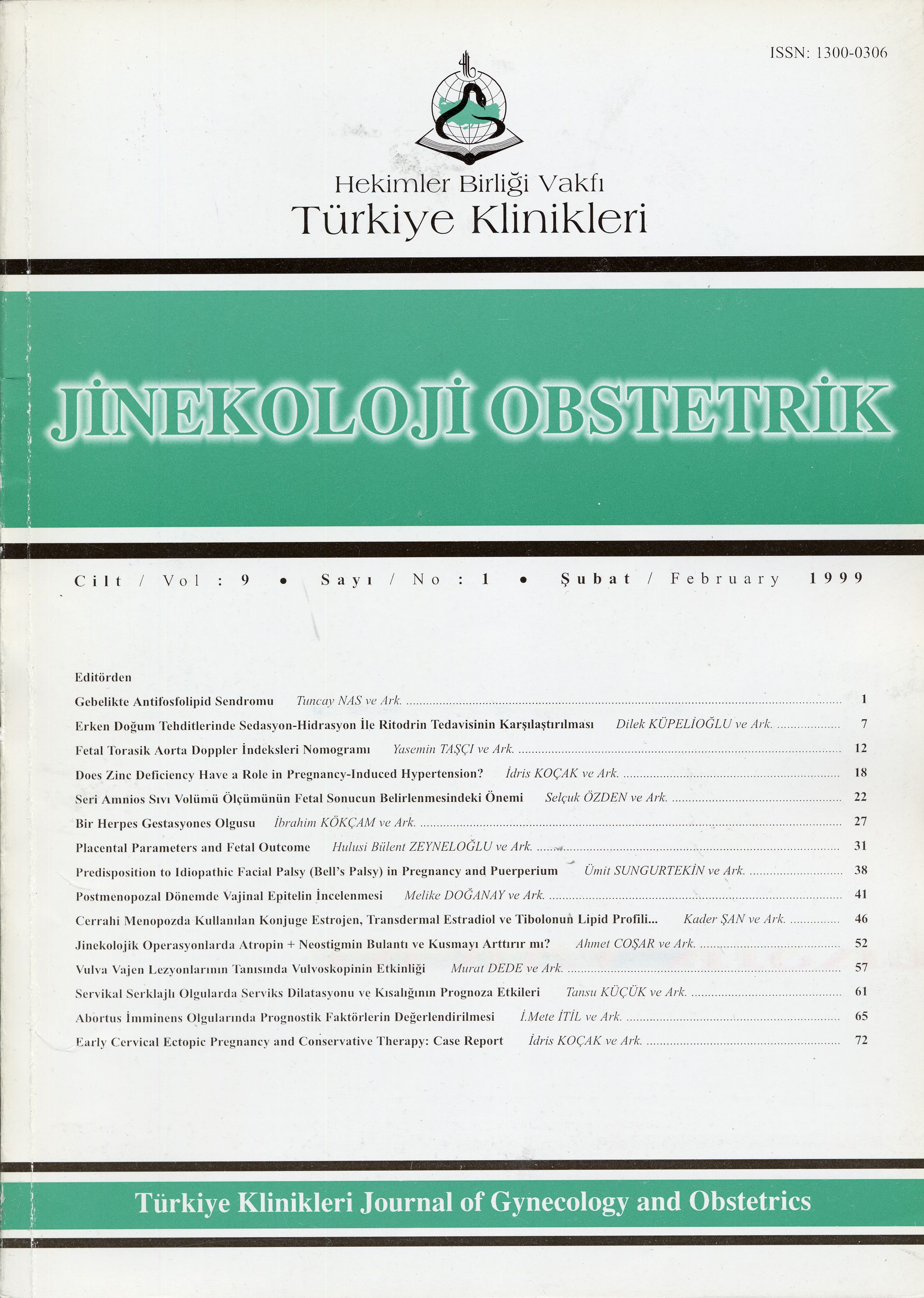Open Access
Peer Reviewed
ARTICLES
2573 Viewed768 Downloaded
Predisposition to Idiopathic Facial Palsy (Bell's Palsy) in Pregnancy and Puerperium
Gebelik Ve Puerperiumda İdiopatik Fasyal Palsi (Bell Palsisi) Görülme Eğilimi
Turkiye Klinikleri J Gynecol Obst. 1999;9(1):38-40
Article Language: TR
Copyright Ⓒ 2020 by Türkiye Klinikleri. This is an open access article under the CC BY-NC-ND license (http://creativecommons.org/licenses/by-nc-nd/4.0/)
ÖZET
Amaç: İdiopatik fasyal palsi (Bell palsisi) nadir ve nedeni bilinmeyen bir bozukluktur. Gebelik ve puerperiumda görülme insidansı daha yüksek olarak belirtilmektedir. Obstetrisyenler gebelikte böyle bir olgu ile karşılaşıp tedavi planını yapmak zorunda kalabileceği için, son zamanlarda karşılaştığımız bir olgu ile bu konuyu tekrar gözden geçirmek istedik. Çalışmanın Yapıldığı Yer: Celal Bayar Üniversite Hastanesi Materyel ve Metod: Gebeliğin 30. Haftasında idiopatik fasyal palsi saptanan primigravid bir gebe Bulgular: İdiopatik fasyal palsi tanısı konulunca derhal fizyoterapi ve yüksek doz B vitamini tedavisi uygulandı. Sağlıklı bir erkek bebek doğurduktan sonra, tam iyileşme saptandı. Sonuç: Gebelikte idiopatik fasyal palsinin daha sık görülmesinin nedeni, gebelikteki immun değişikliklere bağlı olarak, lokal ödeme yol açarak nöral bası yaratan Herpes simplex aktivasyonu yoluyla açıklanabilir. Prognoz, özellikle hasta genç ise oldukça iyidir. Erken fizyoterapi iyi sonuç için son derece önemlidir.
Amaç: İdiopatik fasyal palsi (Bell palsisi) nadir ve nedeni bilinmeyen bir bozukluktur. Gebelik ve puerperiumda görülme insidansı daha yüksek olarak belirtilmektedir. Obstetrisyenler gebelikte böyle bir olgu ile karşılaşıp tedavi planını yapmak zorunda kalabileceği için, son zamanlarda karşılaştığımız bir olgu ile bu konuyu tekrar gözden geçirmek istedik. Çalışmanın Yapıldığı Yer: Celal Bayar Üniversite Hastanesi Materyel ve Metod: Gebeliğin 30. Haftasında idiopatik fasyal palsi saptanan primigravid bir gebe Bulgular: İdiopatik fasyal palsi tanısı konulunca derhal fizyoterapi ve yüksek doz B vitamini tedavisi uygulandı. Sağlıklı bir erkek bebek doğurduktan sonra, tam iyileşme saptandı. Sonuç: Gebelikte idiopatik fasyal palsinin daha sık görülmesinin nedeni, gebelikteki immun değişikliklere bağlı olarak, lokal ödeme yol açarak nöral bası yaratan Herpes simplex aktivasyonu yoluyla açıklanabilir. Prognoz, özellikle hasta genç ise oldukça iyidir. Erken fizyoterapi iyi sonuç için son derece önemlidir.
ABSTRACT
Objective: Although idiopathic facial palsy or Bells palsy is an infrequent enigmatic disorder it has higher incidence in pregnancy and puerperium. Since obstetricians may be obligated to manage the Bells palsy in relation to pregnancy, we wish to review this subject by a recently encountered case. Instutition: Celal Bayar University Hospital Material and Method: A 23 year-old primigravid woman presented with Bells palsy at 30th week of pregnancy. Results: She was treated with physiotherapy and high dose B-group vitamins as soon as the diagnosis of idipathic facial palsy was established. After she has delivered a healty baby boy , complete reversal was confirmed. Conclusion: Higher incidence in relation to pregnancy may be explained with Herpes simplex activation due to immunological alteration in pregnancy, causing local edema, and thus, resulting in neural compression. The prognosis is good, especially when the patient is young. The earlier physiotherapy is the key for better outcome.
Objective: Although idiopathic facial palsy or Bells palsy is an infrequent enigmatic disorder it has higher incidence in pregnancy and puerperium. Since obstetricians may be obligated to manage the Bells palsy in relation to pregnancy, we wish to review this subject by a recently encountered case. Instutition: Celal Bayar University Hospital Material and Method: A 23 year-old primigravid woman presented with Bells palsy at 30th week of pregnancy. Results: She was treated with physiotherapy and high dose B-group vitamins as soon as the diagnosis of idipathic facial palsy was established. After she has delivered a healty baby boy , complete reversal was confirmed. Conclusion: Higher incidence in relation to pregnancy may be explained with Herpes simplex activation due to immunological alteration in pregnancy, causing local edema, and thus, resulting in neural compression. The prognosis is good, especially when the patient is young. The earlier physiotherapy is the key for better outcome.
MENU
POPULAR ARTICLES
MOST DOWNLOADED ARTICLES





This journal is licensed under a Creative Commons Attribution-NonCommercial-NoDerivatives 4.0 International License.











